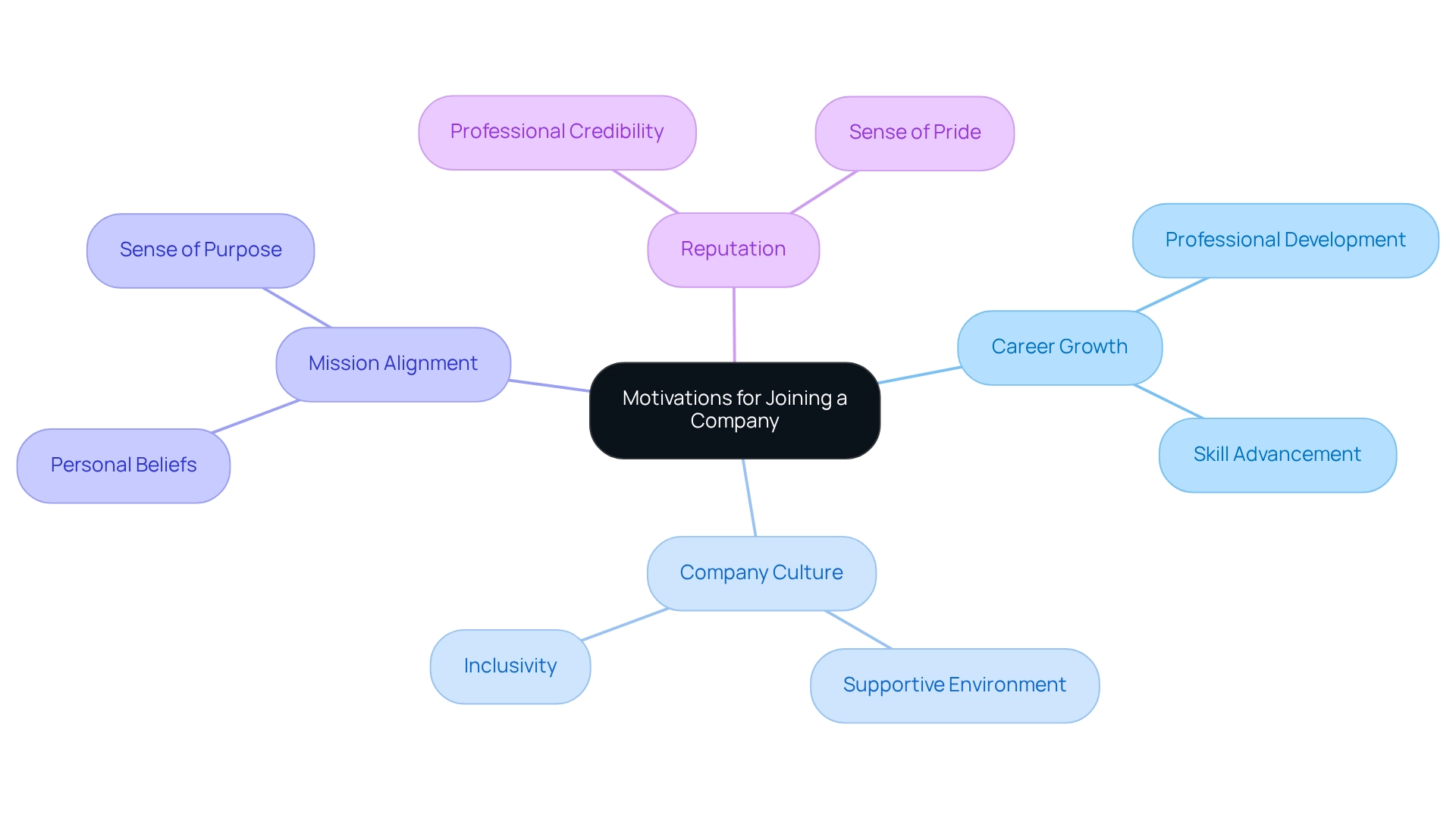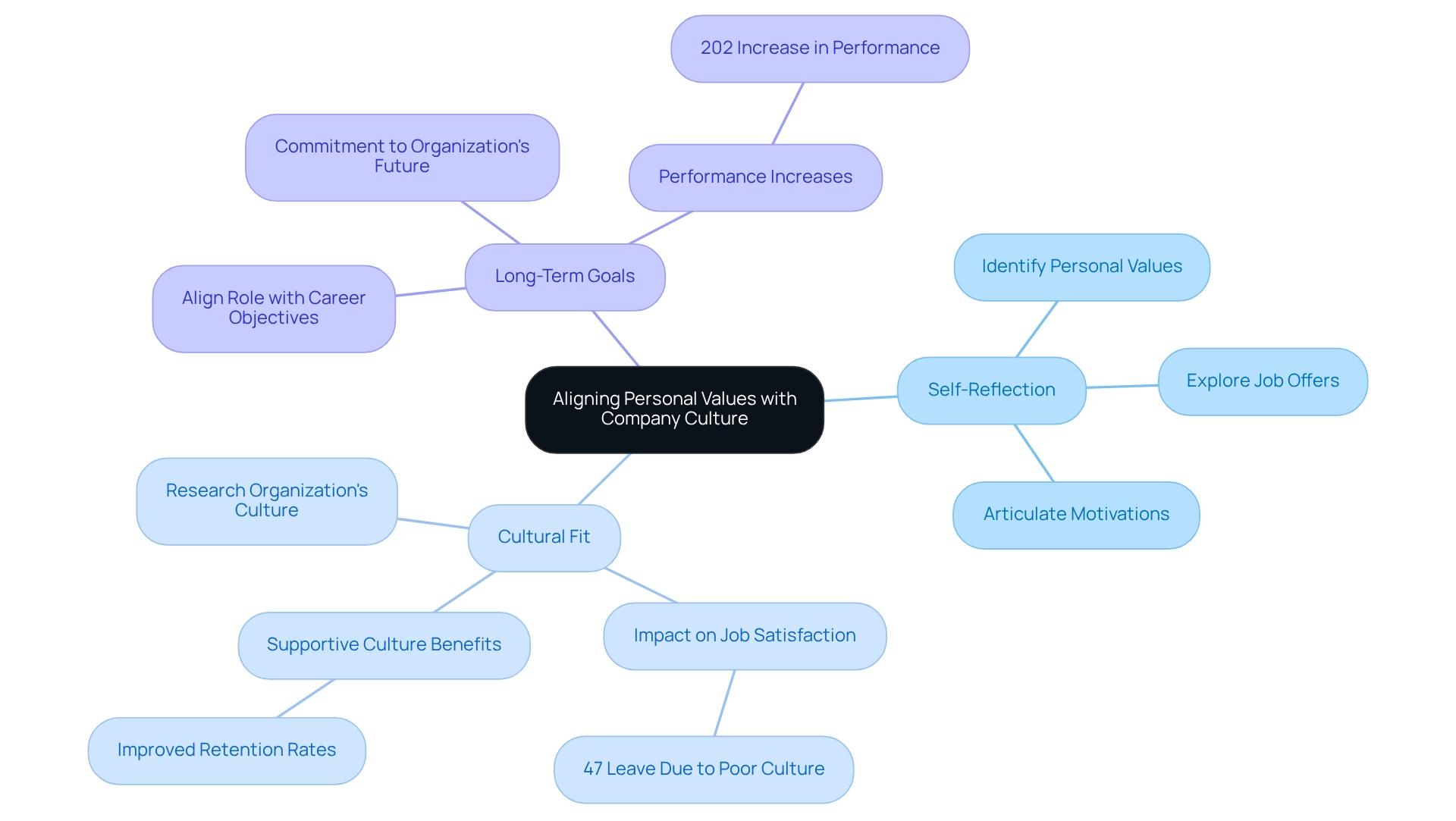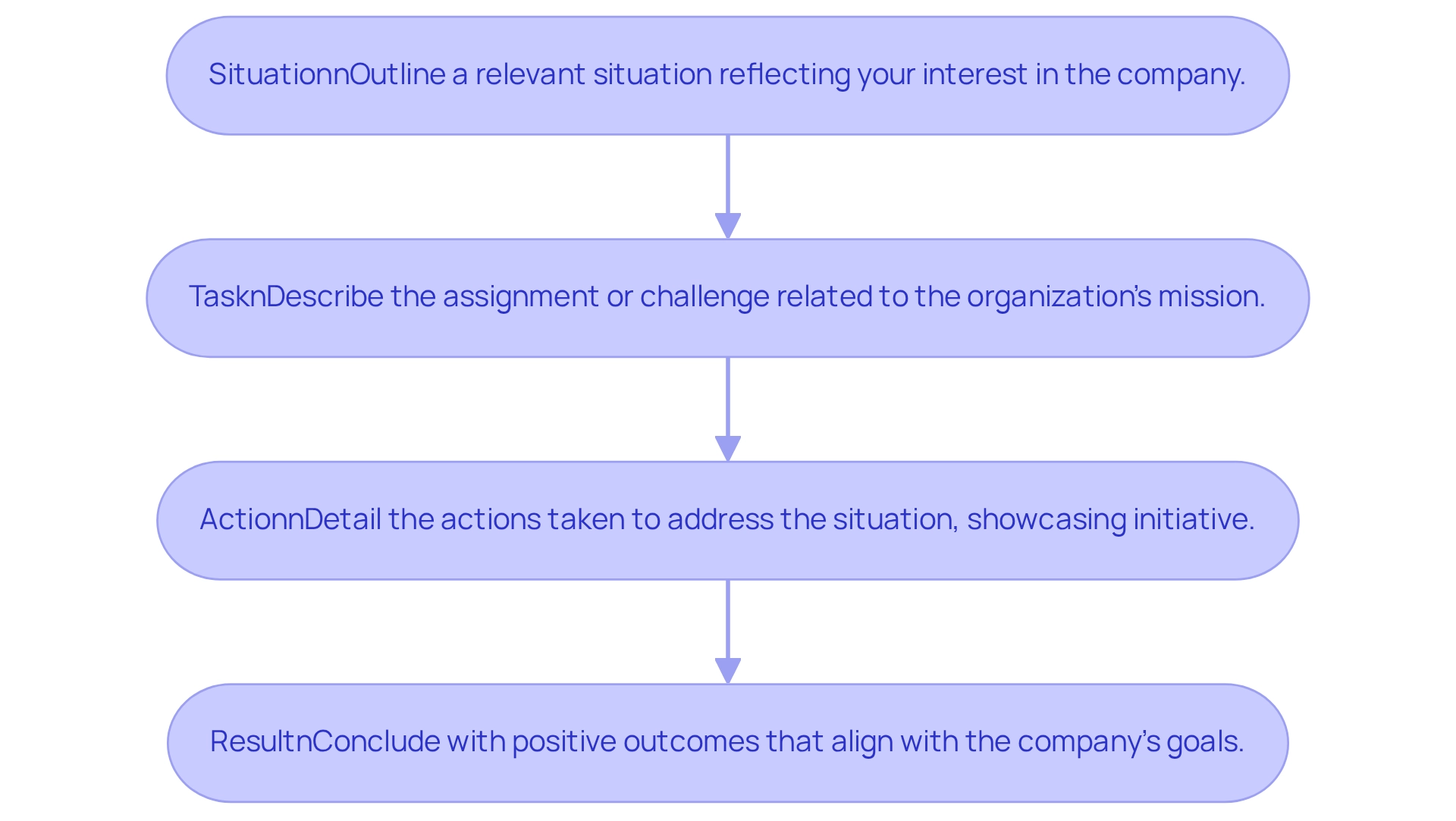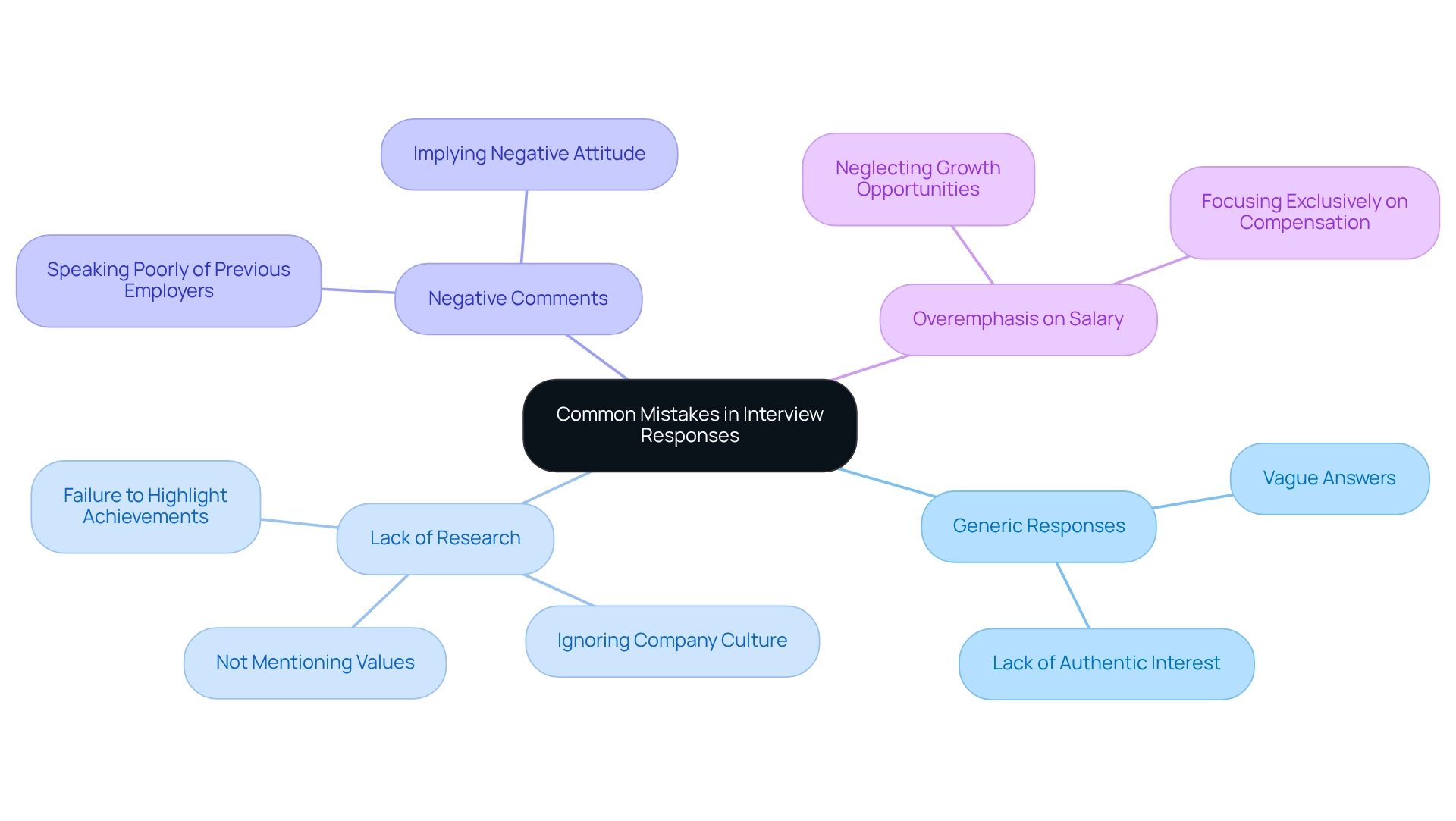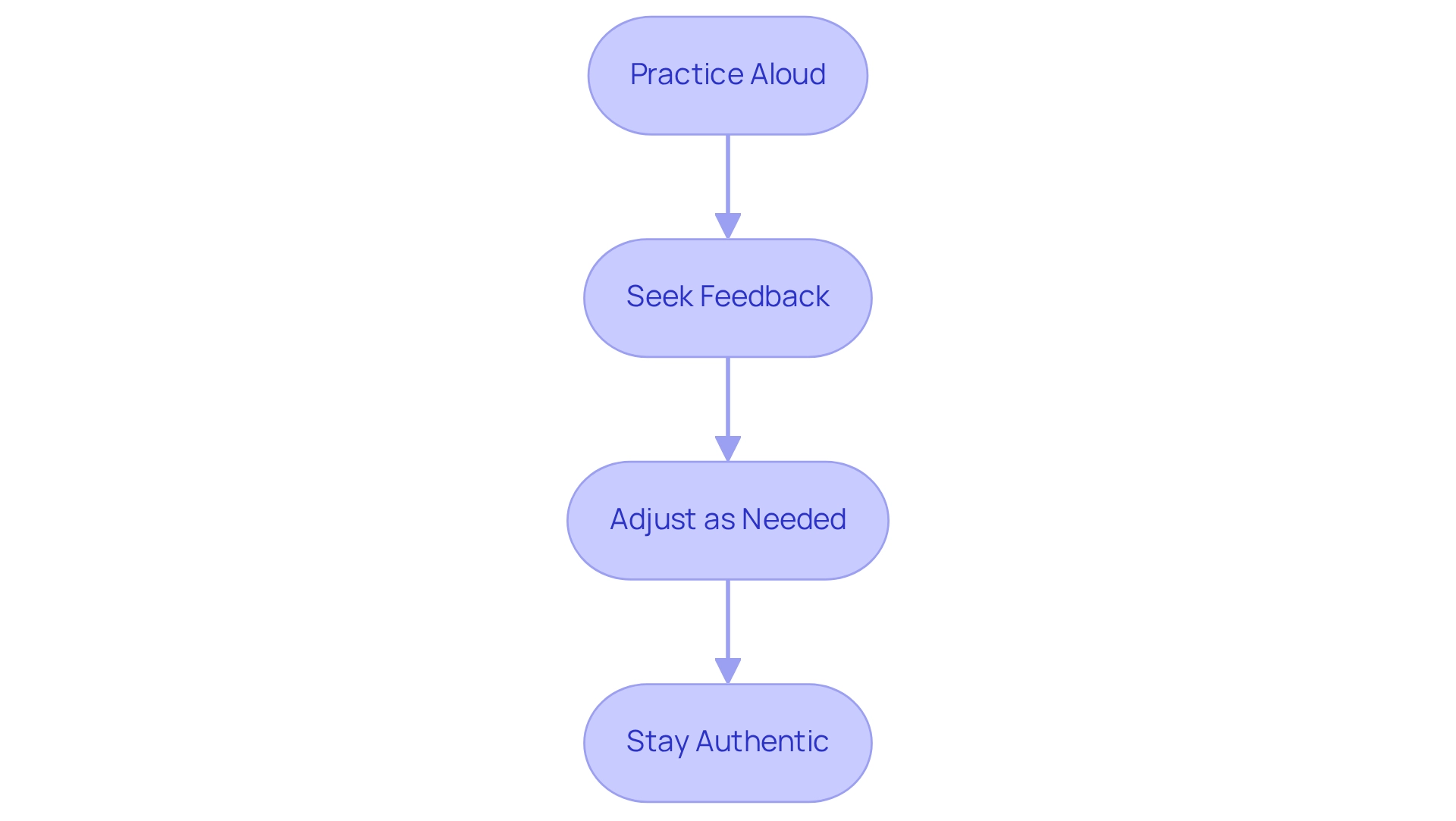Overview
The optimal response to “Why do you want to work here?” should embody a candidate’s authentic enthusiasm and alignment with the company’s core values and mission. It is crucial to conduct thorough research into the organization’s culture and achievements. Furthermore, employing structured responses, such as the STAR method, can effectively articulate personal motivations and demonstrate suitability for the role.
- Have you considered how your values resonate with those of the organization?
- This alignment not only enhances your candidacy but also reflects a deeper understanding of the role you aspire to fill.
Key Highlights:
- The question ‘Why do you want to work here?’ assesses an applicant’s enthusiasm and alignment with the organization’s values.
- A well-articulated response can enhance an applicant’s appeal during the interview process.
- Candidates should align personal aspirations with the company’s objectives to illustrate their suitability.
- Transparency about motivations, workstyle preferences, and salary expectations is crucial.
- Researching the company’s mission, culture, and recent achievements helps tailor responses effectively.
- Common motivations for candidates include career growth, company culture, mission alignment, and reputation.
- Using the STAR method (Situation, Task, Action, Result) can structure responses effectively.
- Avoid generic answers, lack of research, negative comments about past employers, and overemphasis on salary.
- Practicing responses aloud and seeking feedback can improve delivery and authenticity.
- Timely communication, such as thank-you notes, can positively influence hiring decisions.
Introduction
In the competitive landscape of job interviews, one question emerges as a pivotal moment for candidates: “Why do you want to work here?” This inquiry not only gauges a candidate’s enthusiasm but also their understanding of the company’s mission and values.
Crafting a thoughtful response can significantly enhance a candidate’s appeal, showcasing their alignment with the organization and their potential contributions. By exploring motivations such as:
- Career growth
- Company culture
- Mission alignment
candidates can articulate compelling reasons for their interest in the role.
Furthermore, thorough research and self-reflection are essential in preparing for this question, allowing candidates to connect their personal aspirations with the company’s objectives. As the recruitment process evolves, mastering this question can distinctly set candidates apart in their pursuit of the right job with the right company.
Understanding the Significance of ‘Why Do You Want to Work Here?’
The question ‘What is the best answer for why do you want to work here?’ is crucial. Providing the best answer for this inquiry is a fundamental aspect of job evaluations, serving as a vital indicator of an applicant’s genuine enthusiasm for the role and their alignment with the organization’s values and culture. This inquiry not only evaluates enthusiasm but also indicates how well applicants comprehend the organization’s mission.
A thoughtfully articulated response can significantly enhance an applicant’s appeal, making it an essential aspect of the interview process. Individuals should approach this question as an opportunity to align their personal aspirations with the company’s objectives. By doing so, they can effectively illustrate their suitability for the role and their potential contributions to the organization. Embracing transparency during this discussion is vital; individuals should be forthcoming about their motivations, workstyle preferences, salary expectations, and any unique circumstances that may influence their suitability for the role.
For instance, if an applicant has a strong preference for remote work, they should explain why this arrangement is important and how they plan to ensure effective communication and collaboration. Studies show that 40% of assessors believe a person’s overall confidence plays a crucial role in recruitment choices, highlighting the significance of providing a self-assured and well-prepared response. Furthermore, prompt communication after the meeting, such as sending thank-you notes, can positively affect hiring managers’ impressions.
The case study titled ‘The Impact of Timely Communication on Hiring Decisions’ emphasizes that individuals who follow up swiftly after discussions can significantly influence hiring managers’ views and choices. This underscores the importance of not only delivering the best answer for why do you want to work here effectively but also maintaining engagement throughout the recruitment journey. Additionally, almost half of applicants (46%) indicated that an interviewer’s demeanor or conduct could cause them to withdraw from the hiring process, highlighting the essential nature of the selection environment.
To create a persuasive response, applicants should concentrate on showcasing alignment with the organization’s values. This can be achieved by researching the organization’s mission, recent achievements, and culture, and then articulating how their skills and experiences resonate with these elements. For instance, an applicant might say, ‘I admire your commitment to innovation and sustainability, which aligns with my passion for creating impactful solutions in my work.’ Such replies not only demonstrate enthusiasm but also indicate a profound comprehension of the organization.
Examples of successful interview responses often feature specific mentions of the organization’s projects or values, illustrating an applicant’s sincere interest. For instance, an applicant might mention a recent initiative the company undertook and express excitement about contributing to similar projects. Furthermore, applicants can share personal insights that have influenced their professional development, enhancing a deeper connection with the hiring manager.
In summary, the question ‘What is the best answer for why do you want to work here?’ is important to consider. This serves as the best answer for why do you want to work here, providing a crucial opportunity for applicants to align their personal aspirations with the organization’s mission while showcasing both their enthusiasm and their suitability for the role. By preparing thoughtful, value-aligned responses and embracing transparency, including discussions about workstyle preferences and salary expectations, applicants can significantly enhance their chances of making a positive impression during the interview process.
As Eric Eddy pointed out, the firm’s capacity to provide exceptional applicants swiftly and effectively highlights the significance of clear communication and presentation in the recruitment process.
Common Motivations for Wanting to Join a Company
Candidates are often driven by a range of motivations when considering a new job opportunity, with key factors including career advancement, alignment with personal values, and the desire to engage in meaningful work. Comprehending these motivations can significantly improve how individuals express their interest in a specific organization. Common motivations include:
- Career Growth: Many candidates prioritize opportunities that facilitate professional development and advancement. In fact, statistics show that organizations providing clear career advancement are more likely to attract top talent, as individuals increasingly seek positions that promise growth and skill development. Boutique Recruiting emphasizes this by encouraging applicants to explore multiple job offers, ensuring they find positions that truly align with their long-term career goals.
- Company Culture: A positive and inclusive work environment is a major draw for applicants. Studies indicate that applicants are more inclined to seek positions at organizations that exhibit a dedication to cultivating a supportive environment, which can result in increased job satisfaction and retention rates. Boutique Recruiting’s tailored method assists applicants in evaluating organizational culture during the hiring process, ensuring they discover a workplace that aligns with their values.
- Mission Alignment: Candidates often gravitate towards companies whose missions resonate with their personal beliefs. This alignment not only boosts job satisfaction but also cultivates a sense of purpose, making individuals feel that their work contributes to a greater cause. Boutique Recruiting helps individuals in finding organizations that align with their values, improving their overall job satisfaction.
- Reputation: The standing of a business can greatly affect an applicant’s choice to submit an application. Working for a respected organization not only enhances an applicant’s professional credibility but also provides a sense of pride and belonging. Boutique Recruiting’s impressive track record of successful placements reinforces the credibility of the companies they represent, making them more attractive to top talent.
It is essential to recognize that leading job applicants usually stay accessible for only around 10 days in the job market, highlighting the urgency of comprehending their motivations. By acknowledging and expressing these motivations, applicants can create persuasive responses that connect with potential employers, showcasing the best answer for why do you want to work here and demonstrating their authentic interest in the organization and its values. For example, a case study on improving applicant experience after an offer emphasizes that involving new employees during the time between offer acceptance and start date can cultivate brand loyalty and raise the chances of referrals.
This highlights the significance of aligning applicant motivations with the company’s culture and growth opportunities, ultimately resulting in successful placements and satisfied employees. Furthermore, as highlighted by Niels Rozemeijer, ‘65% of satisfied individuals are likely to engage in business with you once more,’ underscoring the significance of satisfaction among applicants and its effects on recruitment. Boutique Recruiting’s impressive track record of success and numerous satisfied clients and applicants further reinforces the credibility of these insights.
To ensure you make the best decision for your career, consider reaching out to Boutique Recruiting. Our team is dedicated to helping you navigate the job market and find opportunities that align with your goals and values. Don’t miss out on the chance to explore multiple offers and secure the position that’s right for you.
Researching the Company: Key Areas to Explore
To effectively answer the question, ‘Why do you want to work here?’, individuals must conduct thorough research regarding the organization, especially in today’s competitive talent environment. Key areas to explore include:
- Company Mission and Values: A deep understanding of the company’s core mission and values is essential. This knowledge allows applicants to align their responses with the organization’s principles, demonstrating a shared vision and commitment—crucial as top individuals seek the right fit.
- Recent News and Achievements: Staying informed about recent developments or notable accomplishments can provide valuable context for an applicant’s interest. For instance, being aware of a recent accolade or a successful product introduction can assist applicants in expressing their enthusiasm and relevance to the organization’s current direction, highlighting their proactive strategy in a competitive job market.
- Company Culture: Gaining insights into the work environment is crucial. Understanding the organizational culture enables candidates to convey why they would excel in that environment, emphasizing their suitability with the team and institutional values—becoming increasingly important as candidates assess prospective employers.
- Products and Services: Familiarity with the organization’s offerings is vital. Candidates should be able to discuss specific products or services, showcasing genuine enthusiasm and a proactive approach to understanding the business.
Candidates can utilize various resources to gather this information, including the company’s official website, social media platforms, and recent news articles. This thorough preparation not only enhances the quality of their responses but also significantly boosts their confidence during the evaluation process. Research indicates that 72% of applicants believe that the effectiveness of the selection process—being well-prepared—influences their decision to accept job offers.
Therefore, informed and relevant responses can significantly improve an applicant’s chances of creating a positive impression. As Lee Ann Prescott noted, “Improving the application experience is a powerful way to attract more talent.” Furthermore, with 93% of firms anticipated to invest in recruitment technology in 2025, applicants should understand how these advancements can influence their preparation and the overall experience during the selection process.
The case study on assessment efficiency and job acceptance further reinforces that thorough preparation can significantly influence applicants’ decisions.
Additionally, applicants should be discerning during the interview process, actively searching for warning signs that may suggest a misalignment with their values or expectations. This proactive assessment is crucial, as candidates are not merely looking for any position, but the suitable role with the right organization.
Aligning Personal Values with Company Culture
Aligning personal values with an organization’s culture is crucial for crafting a compelling response to the question, “Why do you want to work here?” Candidates should focus on several key areas:
- Self-Reflection: Begin by identifying personal values and career aspirations that resonate with the company’s mission. This introspection enables individuals to articulate their motivations effectively. It’s essential for applicants to explore all available job offers, as the first option may not always be the best. By considering multiple opportunities, candidates gain a clearer understanding of how their values align with potential employers, uncovering unexpected benefits that may enhance their professional growth.
- Cultural Fit: Understanding the organization’s culture is paramount. Candidates must research how their work styles and ethics align with the organization’s values. A strong cultural fit not only enhances job satisfaction but also significantly impacts employee retention; statistics reveal that 47% of job seekers would leave their current roles due to unfavorable workplace culture. Furthermore, a case study titled ‘The Role of Organizational Culture in Employee Retention’ underscores that businesses with a supportive culture experience improved retention rates. This highlights the necessity for applicants to align with the organization’s values. Candidates should also be wary of the trap of accepting the first job offer, as it may not provide the optimal fit or growth opportunities. An organization that values its staff will assist individuals in making informed choices, recognizing the importance of this decision.
- Long-Term Goals: Candidates should clearly articulate how the role aligns with their broader career objectives. Emphasizing a commitment to the organization’s future can effectively answer the question, “Why do you want to work here?” by showcasing a candidate’s potential for lasting contributions. In fact, organizations with highly engaged employees can experience a remarkable 202% increase in performance, reinforcing the significance of motivation and alignment in the workplace. Additionally, it’s noteworthy that 63% of U.S. companies find it more challenging to retain than to hire workers, emphasizing the critical role of cultural fit in recruitment strategies. Committing too quickly to a job offer may lead to regret; thus, applicants should weigh their options carefully.
By effectively expressing this alignment, individuals can demonstrate their potential to contribute positively to the organization, enhancing their appeal to employers who prioritize cultural fit in their hiring processes. As Eric Eddy from CPA Resources Global Professionals notes, the firm’s ability to provide exceptional individuals swiftly and efficiently is significantly enhanced when individuals resonate with the organizational culture. This approach not only boosts the applicant’s chances of securing the position but also fosters a more engaged and productive workforce.
Structuring Your Answer: Tips and Techniques
To effectively articulate your motivation for wanting to work here, candidates can leverage the STAR method (Situation, Task, Action, Result) as a strategic framework:
-
Situation: Begin by briefly outlining a relevant situation that reflects your genuine interest in the company. This could involve a personal experience or a specific aspect of the organization that resonates with you.
-
Task: Subsequently, describe the assignment or challenge you faced that relates to the organization’s mission or values. This contextualizes your interest and demonstrates your understanding of what the organization represents.
-
Action: Detail the actions you took to address the situation, highlighting your proactive approach. By emphasizing your initiative, you not only showcase your problem-solving abilities but also align your skills with the organization’s needs.
-
Result: Conclude with the positive outcomes of your actions, connecting them back to how they align with the company’s goals. This final step reinforces your fit for the organization and illustrates the potential value you can bring.
This structured approach ensures that applicants express their ideas clearly and effectively, significantly enhancing their chances of making a strong impact on interviewers. Research indicates that stress can lead to incomplete responses and performance anxiety during interviews, making a clear structure even more critical. By utilizing the STAR method, applicants can provide concrete examples rather than hypothetical responses, which is often more compelling to hiring managers.
Expert insights suggest that before employing the STAR method, applicants should clarify what success entails for the position and the organization. Brooke Niass, a Senior Talent Advisor at ING, emphasizes, “Before you use the STAR method, you need to define what success looks like for the role and the organization. What are the key competencies, skills, and behaviors that you are seeking in the ideal applicant?”
Understanding these elements allows for a more tailored response. This preparation can be further supported by using a scoring rubric or checklist to evaluate the effectiveness of each response, ensuring that candidates not only answer the question but do so in a way that resonates with the interviewers.
Additionally, referencing Boutique Recruiting’s differentiation strategy highlights how understanding company culture and specific job requirements can lead to successful placements. This connection underscores the significance of a smooth assessment process in attracting top talent, especially in specialized legal roles. While the STAR method is effective, it is also beneficial to acknowledge alternative assessment strategies such as competency-based discussions and structured evaluations to provide a more comprehensive view of assessment techniques.
Examples of Effective Responses to ‘Why Do You Want to Work Here?’
Effective responses to the question ‘Why do you want to work here?’ can significantly influence the outcome of a meeting, especially in a competitive job market where, on average, 118 individuals apply for each position. In this environment, top candidates are not merely searching for any role; they are pursuing the right position with the appropriate organization.
Candidates are also vigilant for red flags during the interview process, making it essential for hiring managers at Boutique Recruiting to manage the interview process seamlessly. Here are some compelling examples that demonstrate how candidates can articulate their motivations while aligning with the company’s values:
- Example 1: “I admire your commitment to innovation and sustainability, which aligns with my personal values. My background in environmental science equips me to contribute meaningfully to your ongoing projects in this area.”
- Example 2: “Having observed your organization’s growth for years, I am impressed by your dedication to employee development. I am eager to leverage my project management skills within a team that prioritizes continuous learning and growth.”
- Example 3: “Your recent initiative to enhance community engagement resonates deeply with my passion for social responsibility. I would love to join a team that prioritizes making a positive impact in the community.”
These examples illustrate the importance of linking personal motivations to the organization’s mission, ultimately providing the best answer to why candidates want to work there and making responses not only relevant but also compelling. According to Ryan Bradshaw, 80% of job seekers have opted out of job offers due to poor interview experiences, underscoring the necessity for hiring managers at Boutique Recruiting to handle the interview process seamlessly. Customizing responses to demonstrate authentic interest and alignment with the organization’s values can enhance an applicant’s success rate in securing job offers.
Moreover, a case study titled ‘Applicant Experience and Recruitment Process’ highlights that a positive applicant experience, characterized by clear communication and transparency, is essential for attracting and retaining top talent. By expressing motivations clearly and linking them to the organization’s objectives, applicants can leave a lasting impact that resonates with hiring managers. Furthermore, as technology continues to shape the recruitment landscape, understanding AI-driven hiring capabilities can provide applicants with insights into how their responses might be interpreted.
Ultimately, incorporating practices such as blind hiring can help reduce bias in the recruitment process, further aligning with the overarching theme of creating a positive experience for applicants.
Common Mistakes to Avoid in Your Response
When addressing the question, ‘Why do you want to work here?’, individuals must be aware of several common pitfalls that can undermine their responses:
- Generic Responses: Avoid vague answers that could apply to any organization, such as ‘I want a job’ or ‘I need the money.’ These responses fail to demonstrate authentic interest and can make applicants appear unprepared.
- Lack of Research: Not mentioning specific aspects of the organization, such as its values, culture, or recent achievements, indicates a lack of preparation. Conducting thorough research to tailor answers is essential, as it showcases an understanding of the organization and its goals.
- Negative Comments: Speaking negatively about previous employers or experiences can reflect poorly on the applicant. This not only raises concerns about professionalism but also implies a potential negative attitude toward the new workplace.
- Overemphasis on Salary: While compensation is important, focusing exclusively on salary can signal a lack of dedication to the organization’s mission and values. Applicants should express interest in growth opportunities, company culture, and alignment with their career objectives.
By steering clear of these pitfalls, individuals can craft genuine and persuasive responses to ‘Why do you want to work here?’. Embracing honesty during the selection process is crucial; applicants should be forthright about their motivations for pursuing a new position, whether for career advancement, new challenges, or a change in their work environment. Research indicates that generic responses can significantly affect hiring choices, as employers often seek applicants who exhibit a clear understanding of and enthusiasm for both the role and the organization.
Moreover, a recent survey disclosed that 28% of participants support online job assessments, underscoring the evolving recruitment landscape and the necessity for applicants to adjust their strategies accordingly. Additionally, data indicates that top-notch applicants typically secure new positions within ten days, highlighting the importance of making a strong impression during evaluations. Candidates who submit up to ten applications have a 27.2% chance of receiving a job offer, illustrating that while the job search can be challenging, the likelihood of success increases with effort and tailored applications.
As Ryan Bradshaw observes, ‘53% of HR professionals believe that VR will become common in interviewing within the next five years,’ suggesting that applicants must stay informed about evolving interview practices. By avoiding common errors and focusing on tailored, well-researched replies, applicants can significantly enhance their chances of securing the desired position. Boutique Recruiting’s impressive track record of success and numerous satisfied clients and applicants further underscore the importance of personalized service in the recruitment process.
Final Tips: Practicing Your Answer for Success
To excel in answering ‘Why do you want to work here?’ individuals should adopt a strategic approach that includes several essential steps:
- Practice Aloud: Rehearsing your answer out loud is crucial. It helps you become comfortable with the wording and flow, allowing for a more natural delivery during the interview. This practice is vital, particularly in a competitive hiring environment where applicants are assessing your organization just as much as you are assessing them.
- Seek Feedback: Sharing your response with a friend or mentor can provide valuable insights. Constructive feedback is essential, as nearly half of applicants (46%) indicate that an interviewer’s demeanor can cause them to withdraw from the recruitment process. This emphasizes the significance of delivering the best answer for why you want to work here—one that resonates positively and shows readiness, ensuring that applicants feel respected and valued during the interview.
- Adjust as Needed: Be open to refining your answer based on the feedback received and personal reflection. This iterative process can significantly enhance your response, making it more aligned with what employers are looking for. Candidates should be aware that inconsistencies in responses from interviewers can raise red flags, so clarity and alignment are key.
- Stay Authentic: Ensure that your response feels genuine and reflects your true motivations. Authenticity can distinguish you; hiring managers value individuals who show sincerity in their interest. This is especially significant during a period when applicants seek cultural compatibility and alignment with organizational values.
By employing these strategies, individuals can enhance their confidence and efficiency during discussions. Rehearsing responses not only equips individuals for possible inquiries but also boosts their likelihood of creating a favorable impact. In fact, 80% of hiring managers indicate that receiving a thank-you note influences their decision-making process, with 22% stating it has a significant impact.
This highlights the significance of deliberate communication during the selection process, as it can strengthen an applicant’s interest and professionalism.
Additionally, case studies show that half of employers have lost quality talent due to a subpar selection process, stressing the need for individuals to present themselves effectively. Skilled individuals often have multiple opportunities and may not tolerate disrespect during the hiring process. Therefore, refining your responses during discussions through practice and feedback can be a game-changer in securing the desired position.
As Eric Eddy noted, the firm’s ability to deliver top-notch candidates quickly and efficiently is often a result of thorough preparation and effective communication, which candidates should strive to emulate.
At Boutique Recruiting, we understand the importance of a seamless interview process. Let’s discuss your hiring needs and how we can help streamline the process so that you attract top-notch talent! Search Candidates >
Conclusion
Articulating a compelling response to the question “Why do you want to work here?” is essential for candidates navigating the competitive job market. This inquiry serves as a critical opportunity to showcase alignment with the company’s values, mission, and culture. By emphasizing motivations such as career growth, company culture, and mission alignment, candidates can effectively convey their genuine interest in the organization.
Thorough research and self-reflection are vital components in preparing for this pivotal moment in an interview. Candidates should delve into the company’s mission, recent achievements, and work environment to craft tailored responses that resonate with hiring managers. Avoiding common pitfalls, such as generic answers or overly focusing on salary, can significantly enhance the authenticity and impact of their responses.
Ultimately, the ability to connect personal aspirations with the company’s objectives not only demonstrates enthusiasm but also underscores a candidate’s potential contributions. By adopting a structured approach, such as the STAR method, and practicing answers aloud, candidates can boost their confidence and present themselves effectively during interviews. The journey towards securing the right position involves thoughtful preparation. Those who invest the effort in crafting their responses will stand out in the eyes of employers, fostering a lasting impression that could lead to successful placements.
Take action now—prepare thoroughly, and position yourself as the ideal candidate for your next opportunity.
Frequently Asked Questions
Why is the question “What is the best answer for why do you want to work here?” important in job interviews?
This question is crucial as it serves as a vital indicator of an applicant’s genuine enthusiasm for the role and their alignment with the organization’s values and culture. It evaluates both enthusiasm and the applicant’s understanding of the organization’s mission.
How should applicants approach answering this question?
Applicants should view this question as an opportunity to align their personal aspirations with the company’s objectives. A thoughtful response can enhance their appeal, illustrating their suitability for the role and potential contributions to the organization.
What factors should applicants be transparent about when answering this question?
Applicants should be forthcoming about their motivations, workstyle preferences, salary expectations, and any unique circumstances that may influence their suitability for the role.
How does an applicant’s communication style impact their chances of being hired?
Studies show that 40% of assessors believe an applicant’s overall confidence is crucial in recruitment choices. Providing a self-assured and well-prepared response can positively influence hiring decisions.
What role does follow-up communication play in the hiring process?
Prompt communication after the interview, such as sending thank-you notes, can positively affect hiring managers’ impressions, making timely follow-up an essential part of the recruitment journey.
What should applicants focus on to create a persuasive response?
Applicants should concentrate on showcasing alignment with the organization’s values by researching its mission, recent achievements, and culture, and articulating how their skills and experiences resonate with these elements.
Can you provide an example of a strong response to this question?
A strong response might include specific mentions of the organization’s projects or values, such as saying, “I admire your commitment to innovation and sustainability, which aligns with my passion for creating impactful solutions in my work.”
What common motivations drive candidates when considering a new job opportunity?
Key motivations include career growth, company culture, mission alignment, and the reputation of the organization. Understanding these motivations can improve how candidates express their interest in a specific organization.
How can applicants ensure they find positions that align with their long-term career goals?
Applicants should explore multiple job offers and evaluate organizational culture during the hiring process to discover workplaces that align with their values.
What is the significance of applicant satisfaction in the recruitment process?
Satisfied individuals are more likely to engage with the organization again, emphasizing the importance of aligning applicant motivations with the company’s culture and growth opportunities for successful placements and satisfied employees.

